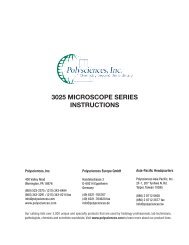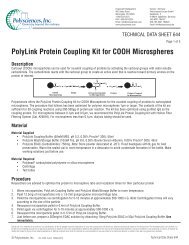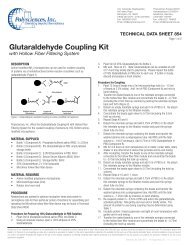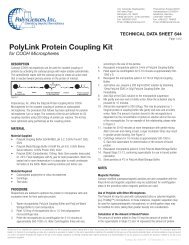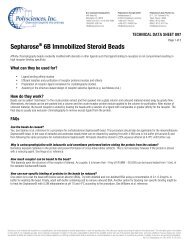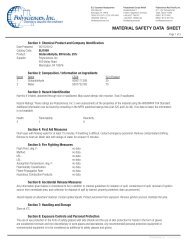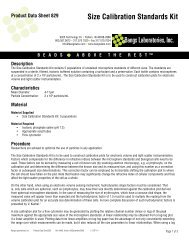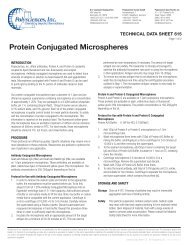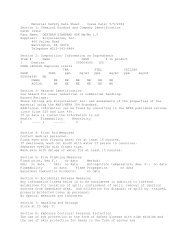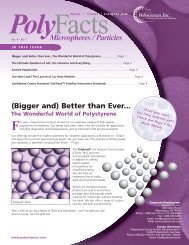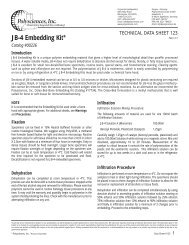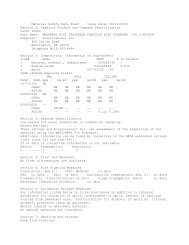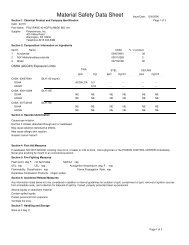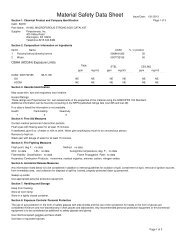BioSciences - Polysciences, Inc.
BioSciences - Polysciences, Inc.
BioSciences - Polysciences, Inc.
Create successful ePaper yourself
Turn your PDF publications into a flip-book with our unique Google optimized e-Paper software.
328<br />
Electronic Adhesives & Encapsulants<br />
as thermal shock. Most thermal cycling is done for 1000 cycles.<br />
The temperature extremes to which the unit is cycled depends on<br />
the intended application as follows:<br />
The JEDEC definition for Thermal Cycling requires<br />
achievement of the temperature limit within 15 minutes.<br />
Realistic Representative Accelerated<br />
Use Environments Test Condition<br />
Application Low High Low High<br />
Temp Temp Temp Temp<br />
Consumer [ 0°C ] [ +60°C ] [ 0°C] [+100°C ]<br />
Automotive [ -40°C ] [+125°C ] [ -40°C] [+105°C ]<br />
Under Hood [ -55°C ] [+150°C ] [ -65°C] [+150°C ]<br />
Industrial [ -55°C] [ +95°C ] [ -50°C] [+150°C ]<br />
Telecomm [ -40°C ] [ +85°C ] [ -50°C] [+125°C ]<br />
Military [ -55°C] [ +95°C ] [ -65°C] [+150°C ]<br />
THERMAL SHOCK: Refers to rapidly moving a test unit from<br />
a chamber at high temperature to another chamber at low<br />
temperature. The chambers can be air to air, or liquid to liquid.<br />
Heat transfer, and stress on the unit, is much higher when the unit<br />
is dipped into a liquid. The liquid/liquid test is more severe than the<br />
air/air test even if the temperature range is the same.<br />
TGA (Thermogravimetric Analyzer): Measures the weight<br />
loss of a Polymer material experiences as it is exposed to increasing<br />
temperature. There are three characteristics of the material that<br />
are of interest:<br />
1. How much weight loss is there as the material cures (since<br />
this loss is almost always a gas, it causes voids if it is high).<br />
2. After curing, if the material is heated above the cure temperature,<br />
does it continue to lose weight (an indication that the<br />
cure was not complete)?<br />
3. Heat the material to very high temperatures and see<br />
at what temperature it begins to deteriorate (when the<br />
polymer breaks down it will exhibit significant weight loss).<br />
TMA (Thermal Mechanical Analyzer): Instrument that<br />
measures the CTE of a material as a function of temperature. Unlike<br />
most common materials, polymer materials exhibit a relatively<br />
sharp change in their CTE as the temperature is increased. The<br />
temperature at which this change in CTE occurs is referred to as<br />
glass transition temperature.<br />
For more information please call (800) 523-2575 or visit: www.polysciences.com<br />
THERMOSET: Polymer material which, once cured remains a<br />
solid at all temperatures. Thermosetting materials will remain solid<br />
until they char (burn) if the temperature is raised high enough, but<br />
they will never become liquid again.<br />
THIXOTROPIC INDEX: Most liquids exhibit constant resistance<br />
to force regardless of how fast the force is applied, e.g.- if you stir a<br />
glass of water, no matter how fast you stir, the water will resist the<br />
force in the same amount (the viscosity does not change). Some<br />
materials (such as most polymers) show a decrease in resistance to<br />
force if the speed at which the force is applied increases. If you stir<br />
a polymer faster, it gets easier to stir (the viscosity decreases). This<br />
phenomenon is called Thixotropic behavior. In order to compare<br />
materials, a standard test is used which is called the Thixotropic<br />
Index. Viscosity is measured at 0.5 RPM and at 5.0 RPM. The<br />
ratio of these two measurements is the Thixotropic index. The<br />
Thixotropic Index of a material determines how well the material<br />
will perform in several key semiconductor packaging applications.<br />
When dispensing die attach adhesive, it is desirable for the material<br />
to flow easily from the syringe. The material should stay in place<br />
without reflow. This kind of behavior is achieved with a Thixotropic<br />
Index of above 5.0<br />
UNDERFILL: When a die is Flip Chip attached, (turned upside<br />
down and it’s pads are attached with solder or conductive epoxy)<br />
the CTE mismatch of the substrate and die can create stress on<br />
the joints causing them to fail over time or extended thermal<br />
cycling. In order to reduce the stress, a polymer material is flowed<br />
or otherwise placed under the flipped die. This material is called<br />
underfill. Underfill that flows under the die after it is attached it is<br />
called conventional underfill. Underfill that is placed under the die<br />
before the die is attached it is called no-flow underfill.<br />
VISCOSITY: The speed of fluid flow and/or the resistance to shear.<br />
Usually measured in Centipoise (cps). Water is 1 cps, cooking oil<br />
is 200 cps, honey is 50,000 cps peanut butter is 1,000,000 cps.<br />
VOID: Any hole in the encapsulant, die attach adhesive<br />
or underfill is called a void. Voids can exist because air is trapped<br />
during the dispense and bond process (the hole is ‘surrounded’<br />
by polymer and gets trapped) or can form because the polymer<br />
releases gas during curing. Voids reduce thermal conductivity<br />
and, if severe, can reduce adhesion strength. They can also trap<br />
moisture and reduce device reliability.<br />
VOLATILES: Any material that evaporates or boils rapidly at the<br />
temperatures at which it is used or processed is said to be volatile.<br />
Many organic materials which are used as solvents are volatile.<br />
If a polymer requires the use of such solvents (because it won’t<br />
flow without their help) it is said to contain volatile materials.<br />
When volatile materials escape, they can create voids and must be<br />
processed accordingly.



